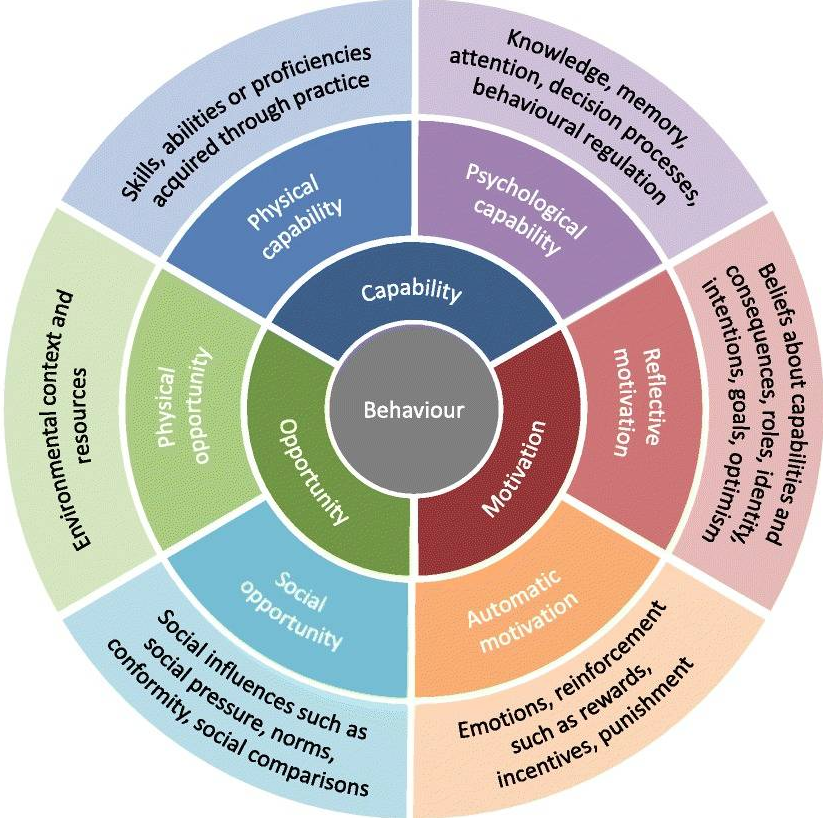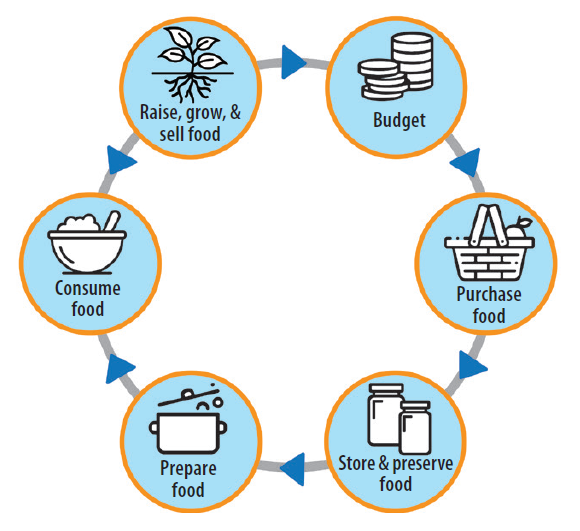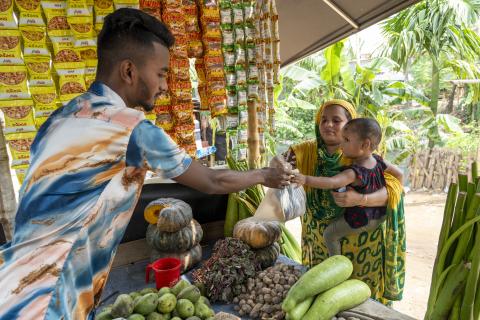Measuring consumer demand to improve diets in Bangladesh and Burkina Faso
Shaneka Thurman Former Senior Advisor for Nutrition-Sensitive Social and Behaviour Change at USAID Advancing Nutrition
Amelia Giancarlo Former Project Officer at USAID Advancing Nutrition
Abigail Conrad Former Senior Advisor for Research and Learning at USAID Advancing Nutrition
Lisa Sherburne Former Director for Social and Behaviour Change at USAID Advancing Nutrition
Silvia Alayon Former Director for Measurement at USAID Advancing Nutrition
Alyssa Klein Former Technical Advisor for USAID Advancing Nutrition
What we know: Consumer demand is a core component of food systems, influencing what producers grow, what markets sell, and what households decide to prepare and serve. Increasing consumer demand for healthy diets can transform food systems, improving access to safe, affordable, and nutritious foods, but it is particularly challenging for lower-income consumers.
What this adds: We identified a need for better metrics of consumer demand for healthy diets among lower-income consumers in low- and middle-income countries, learning from our experiences in Bangladesh and Burkina Faso. We need a shared understanding of consumer demand that focuses on standardised, user-friendly metrics along the programme impact pathway, allowing programme staff to easily analyse and apply any findings.
Background
Economists define consumer demand as the quantity of a good that consumers are willing and able to purchase at various prices during a given period (Sullivan & Sheffrin, 2003). While there is no common definition of consumer demand for healthy diets, it can be influenced by the food environment: availability, affordability, convenience, and desirability (Turner et al., 2018).
USAID Advancing Nutrition conducted a desk review of efforts to increase consumer demand for healthy diets among rural, low-income consumers. We found gaps and differences in how programmes measure such demand. This lack of clear metrics limits how programmes can adapt activities and build a strong evidence base by comparing efforts across different interventions. We applied behavioural theory to determine and test a set of programme-level metrics that practitioners can use to track and evaluate consumer demand generation across programmes. We then worked with two programmes to test those metrics, in Bangladesh and Burkina Faso.
Understanding the gaps
To understand existing knowledge gaps for estimating consumer demand for nutrient-rich foods among public sector nutrition implementers, we first reviewed published literature and programme reports.
We identified three factors within personal food environments that influence consumer demand. Food product attributes (e.g., colour, taste, odour, quality, safety), consumer attributes (e.g., attitudes, beliefs, taste preferences, agency to make decisions), and vendors (e.g., trusted relationships with consumers).
We also identified a wide range of metrics that could be used to assess activities that aim to generate consumer demand. Private sector actors measure demand for nutrient-rich foods using production and sales. Some report the amount of product produced, while others report the amount of product sold to retailers or sales to end-consumers. These metrics offer a simple, real-time gauge of product availability, focusing on the motivation of private sector actors (profit potential). However, this focus makes it difficult to accurately interpret the pathway to demand. We also cannot identify the person in the household who consumes or purchases food (e.g., a child aged under two years or a woman of reproductive age).
Our research findings suggested that public sector partners measure demand generation through food consumption-level indicators (such as minimum dietary diversity) (Kim et al., 2016; Sherburne et al., 2018) and frequency of intake of a particular nutrient-rich food (Kim et al., 2019). As with production and sales metrics, these consumption metrics do not capture the pathway to demand in resource-challenged settings – where the nutrient-rich foods consumed may reflect only what is available and affordable, rather than also what is desired.
Metrics that capture the full pathway of demand generation are lacking in both the private and the public sector. These would tell programmers why consumers can or cannot practise a behaviour, and would include multiple factors such as access, social approval, and perceived skill in food preparation. Programmes that try to “generate demand” require incremental metrics to understand overall impact, barriers and enablers, and where and how to adjust programming. A common, comprehensive set of metrics would enable stakeholders to consistently measure demand generation efforts, compare approaches, and build evidence on what works to increase consumer demand for nutrient-rich food. Therefore, we developed and tested a set of programme-level metrics that quantify the foundational elements of consumer demand.
Developing common indicators of consumer demand
To guide the development of metrics, we first reviewed 3 central theories and behaviour change models. Of these, the ‘behaviour change wheel’ (Figure 1) – which is based on the Capability-Opportunity-Motivation to Behaviour (COM-B) model (Michie et al., 2011) – was selected. ‘Capability’ is divided into physical strength, skills, and psychological ability. ‘Opportunity’ is split into the environment and social opportunities. ‘Motivation’ is seen as automatic and reflective of brain processes through plans and evaluations.
Figure 1: The behaviour change wheela

a McDonagh et al. (2018)
We defined consumer demand in the context of the personal food environment – availability, affordability, convenience, and desirability – coupled with how economists define demand (the quantity of a good that consumers are willing and able to purchase at various prices during a given period). To put this into behavioural terms, we began by looking at household behavioural clusters related to nutrition-sensitive agriculture (Figure 2).
Figure 2: Household nutrition-sensitive agriculture behavioural clusters

To ensure that metrics are useful to programmes that work to generate consumer demand, we chose “repeat purchase of a nutrient-rich food or diet” (depending on the programme) as the behaviour focus. This situates the behaviour between market-based approaches and consumers. “Discuss and decide” was included as a supporting step in the pathways as these actions are necessary for purchase in many households. To focus on consumers who are most vulnerable to poor nutrition outcomes, we defined the consumer demand behaviour as “Low-income consumers regularly purchase nutrient-rich foods.”
We left the decision to choose a specific type of food(s), an individual product, a category of products, or a value chain to each programme, according to where they work to generate demand. This consumer demand outcome is part of a larger pathway to answer the question: “Why is the vulnerable population not consuming food(s) promoted by the programme?”
Based on the literature and behaviour change model described above, we then prioritised the metrics for testing (Table 1).
Table 1: Prioritised consumer demand metrics 1
| Behaviour | Average frequency of household purchase of programme-promoted nutrient-rich food in the previous month a |
| % of households consuming purchased programme-promoted nutrient-rich food in the previous day ab | |
| Capability | % of consumers who know where to buy the programme-promoted nutrient-rich food ab |
| % of consumers who think that locally available programme-promoted nutrient-rich food is safe a | |
| Opportunity | % of consumers who feel they were able to accessc programme-promoted nutrient-rich food in the last month ab |
| % of consumers who paid a price that was at or below what they were expecting to pay for programme-promoted nutrient-rich food a | |
| Motivation | % of consumers who report that family members or trusted influencers expect them to purchase programme-promoted nutrient-rich food ab |
a Tested in Bangladesh
b Tested in Burkina Faso
c We defined access as people being able to go to a market and decide whether they want to buy the food. Affordability was not included here. Affordability questions were separate, and the foods were simply not in the markets at the time of the survey.
Testing metrics in Bangladesh and Burkina Faso
The most pertinent consumer demand objective of our Burkina Faso partner – USAID Yidgiri – was related to income generation among producer households (Box 1). The programme aimed to generate demand for their agricultural products, to increase incomes among these producer households.
For our Bangladesh partner – Feed the Future Bangladesh Nutrition Activity – their most relevant programme objective was the increased consumption of nutritious, diverse, and safe diets by rural households (Box 1). Increasing consumer demand for nutritious foods was a pathway to this outcome. This programme used the metrics we developed to identify whether they were adequately addressing the barriers that consumers face when purchasing foods, as well as to determine whether there were improvements in aspects of consumer demand.
Box 1: Programmes that tested consumer demand metrics for healthy diets Led by Abt Associates, the USAID Feed the Future-funded Bangladesh Nutrition Activity aims to improve the consumption of nutritious, diverse, safe, and balanced diets by households, increase the social and economic empowerment of women and social empowerment of adolescents, and increase adoption of improved water, sanitation, and hygiene practices. |
We worked with both partners to incorporate consumer demand metrics into their annual programme monitoring surveys. To arrive at the list of metrics that programmes would test (Table 1), we analysed programme monitoring, evaluation, and learning plans, as well as each programme’s community, market, and nutrition formative assessments. This allowed us to better understand the factors impacting consumer demand (repeat purchase of programme-promoted foods) in the programme’s focus areas. Analysis of the assessments focused on identifying instances in which the core consumer demand factors were mentioned (such as “mobility to reach the market,” “product availability,” and “price”.). We then worked with programme teams to determine which factors to address based on their relevance to the programme area – as indicated in formative studies – and alignment with the programmes’ performance indicators.
For example, the programme in Bangladesh included questions to understand capability (knowledge of the promoted nutrient-rich foods and food safety) and opportunity (availability and affordability of promoted foods). The findings showed that capability was high in all regions, but pinpointed opportunity challenges for selected foods in selected regions.
The programme in Bangladesh also included a question about whether women believed that family members or trusted influencers expect them to purchase the promoted foods. It highlighted a need to address low perceived family support in 1 region, and to include questions about who and why in the next round of surveys.
We worked with the programmes through four rounds of data collection using the annual household surveys that we helped to design. In Bangladesh, surveys were completed with consumer households. In Burkina Faso, the households were producers who were also consumers. We drew our conclusions from the formative research and the implementation/testing of the metrics of consumer demand.
The way forward
“Develop consensus on the concept of consumer demand”
There are varied definitions of consumer demand and what it takes to generate or measure demand. Many programmes consider consumer demand to be met when dietary intake improves, but do not consider the intermediate steps to consumption (e.g., food choices and purchase). As a result, plans to measure these intermediate steps required additional discussion and support from teams across the programme. The concept of consumer demand must be clearly understood by all programmatic stakeholders to collect and apply monitoring and evaluation data. Although it is better for this understanding to inform programme design, we found that plans could be adjusted during implementation. Greater consensus across donors and implementers would enable programmes to better assess their efforts and compare experiences to build evidence. We offer the consumer behaviour of “repeat purchase of promoted foods” for consideration.
“Select metrics that reflect the impact pathway in the local programme context”
It is unlikely that one set of metrics will be applicable across all programmes to monitor the consumer demand pathway. In Bangladesh and Burkina Faso, access to the promoted nutrient-rich foods was important to measure. This showed that, in both contexts, nutrient-rich foods were simply not available in the markets. However, we also found differences. In Bangladesh, taste preferences were key to decision-making on some promoted vegetables. In Burkina Faso, the foods men and women purchased varied by urban and rural locations. Each programme pathway was developed by understanding the formative research data and being willing to broaden metrics beyond the ‘usual suspects’ of knowledge and attitudes.
We offer the metrics in Table 1 as a starting point for programmes to consider and select indicators that reflect barriers and enablers in the local context. Additional metrics may be needed in some settings. As programmes expand their work in generating consumer demand, building capacity to work with data (for decision-making) and using responsive feedback loops could increase the likelihood of developing programme impact pathways with meaningful metrics.
“Continue to test metrics to inform the development of validated indicators and indicator sets on consumer demand”
This is the first step in a process to identify and develop indicators. Such indicators can inform longer-term efforts to develop a set of quality metrics that can measure programme efforts to generate consumer demand for healthy diets.
Conclusion
Achieving broader food security and nutrition goals is facilitated by extending proven marketing practices to generate demand for nutritious foods to rural, low-income consumers. There is currently little evidence on the effectiveness of approaches to reaching lower-income consumers or improving diet quality (Nordhagen & Demmler, 2023). A key first step is measuring incremental change pathways, from production to consumption, for programmes to ascertain whether demand generation efforts are working and how to improve them.
Our experience – applying a behavioural science theory to develop a set of programme-level metrics on consumer demand for nutritious foods for rural, low-income consumers – is a first step to measuring consumer demand generation plans. We hope that programmes aiming to improve diets continue to review and adapt metrics, such as those offered in this article, to understand and track the incremental pathway to consumer demand.
For more information, please contact Shaneka Thurman at shaneka.thurman@gmail.com.
References
Kim S, Rawat R, Mwangi EM et al. (2016) Exposure to Large-Scale Social and Behavior Change Communication Interventions is Associated with Improvements in Infant and Young Child Feeding Practices in Ethiopia. PLOS ONE, 11, 10, e0164800.
Kim S, Nguyen P, Yohannes Y et al. (2019) Behavior Change Interventions Delivered through Interpersonal Communication, Agricultural Activities, Community Mobilization, and Mass Media Increase Complementary Feeding Practices and Reduce Child Stunting in Ethiopia. The Journal of Nutrition, 149, 8, 1470–1481.
McDonagh L, Saunders J, Cassell J et al. (2018) Application of the COM-B model to barriers and facilitators to chlamydia testing in general practice for young people and primary care practitioners: A systematic review. Implementation Science, 13, 130.
Michie S, van Stralen M & West R (2011) The behaviour change wheel: A new method for characterising and designing behaviour change interventions. Implementation Science, 6, 42.
Nordhagen S & Demmler KM (2023) How do food companies try to reach lower-income consumers, and do they succeed? Insights from a systematic review. Global Food Security, 37, 1-11.
Sherburne L, Math S, Griffiths M et al. (2018) “Grow Together” Campaign in Cambodia: A Game Changer for Children’s Healthy Growth. The NOURISH Project in Cambodia: Grow Together Campaign. advancingnutrition.org.
Sullivan A & Sheffrin S (2003) Economics: Principles in action. Upper Saddle River, New Jersey: Pearson Prentice Hall.
Turner C, Aggarwal A, Walls H et al. (2018) Concepts and critical perspectives for food environment research: A global framework with implications for action in low- and middle-income countries. Global Food Security, 18, 93–101.
1 Although additional metrics were developed, this table only includes metrics that were prioritised for testing (based on a literature review and a programme document review).
About This Article
Download & Citation
Reference this page
Shaneka Thurman, Amelia Giancarlo, Abigail Conrad, Lisa Sherburne, Silvia Alayon and Alyssa Klein (2024). Measuring consumer demand to improve diets in Bangladesh and Burkina Faso. Field Exchange Magazine 72. https://doi.org/10.6084/m9.figshare.25460764


